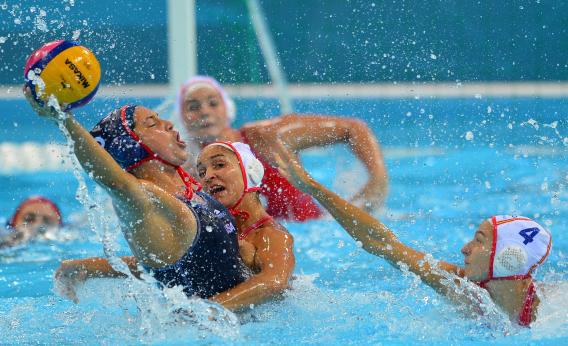For the first year of my high school water polo career, I was really, really bad. I was a fairly strong swimmer, I could catch the ball and, at least half the time, throw it in the general vicinity of one of my teammates. My crippling fear of physical contact, though, kept me out of the pool, relegated to cheering on my more fearless teammates. It took an entire season of this for me to realize that all of the stuff going on below the surface—the grabbing, pushing, shoving, and kicking—were part of the sport, and that I’d have to grab, push, shove, and kick back if I wanted to play.
On Wednesday, the New York Times’ Sam Borden highlighted these more vicious aspects of the game, noting that all the grappling can leave female competitors undressed. A week ago, an American player “pulled at her opponent’s swimsuit and briefly bared a Spanish player’s breast for all to see.” The story also notes that another member of Team USA “played about 10 minutes of a game topless at the 2000 Olympics, when an opponent shredded her suit as they grappled for the ball but play continued.”
On Feministing, Chloe Angyal criticized the Times for focusing on the exposure of “lady bits.” The NYT “could have used this as an opportunity to talk about how rough water polo is, or how swimsuit technology hasn’t yet provided players with suits that don’t rip or stretch away from their bodies,” Angyal wrote. “Instead: boobies! Tee hee hee!”
Though Angyal is right that the Times seems a little too excited about the possibility of seeing a naked boob, I don’t agree that the story was a lost opportunity to talk about toughness. If you watch the women’s gold-medal game between Spain and the United States on Thursday afternoon, you’ll see instantly that water polo is extremely physically demanding. Everyone can tell that the players are swimming hard and fast and without a break, and it’s pretty easy to observe that you have to depend solely on your own legs and swimming ability to keep from drowning.
The facet of the sport that needs more coverage is the below-the-surface physicality—what the Times’ Borden calls “underwater warfare.” If you can look past the mentions of naked players, the NYT piece does well to highlight the sport’s underwater jostling, allowing those who’ve never played water polo to understand an often overlooked aspect of the sport.
Treading water for 30 minutes is hard enough. The simple task of staying afloat becomes nearly impossible when you have another player practically on top of you, grabbing the crotch of your suit and pulling you down with all her might. Yes, water polo is more than just a collection of nip slips and crotch shots. But if it takes a few mentions of “boobies” to expose the difficulty of playing a contact sport in the water, then I’m all for it.
